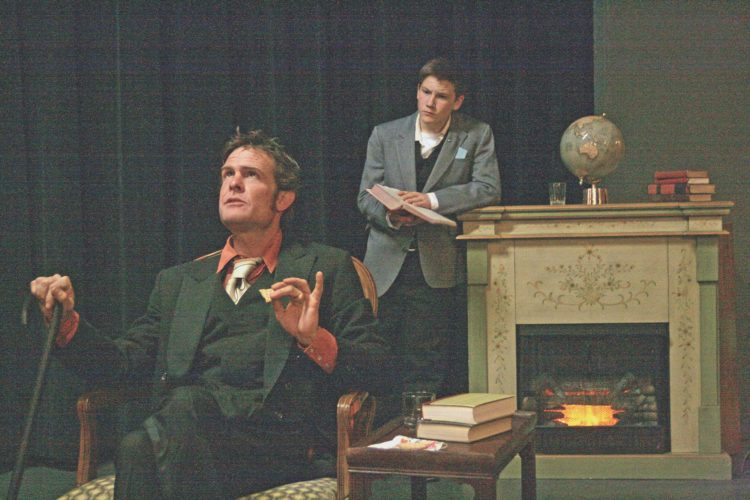The director wasn’t satisfied.
“Do it again,” she said, after we finished the scene.
We did.
“Do it again.”
We did.
“Do it again.”
And so on, until we got it right. Or close enough.
It was my first acting experience at our local community theater (as Sir Toby Belch in Shakespeare’s “Twelfth Night”). I stepped onto the stage directly from my newspaper office, where I am the owner/publisher/editor/part-time reporter/sometime photographer of a small weekly in a rural outpost. I’m not used to being told what to do.
But trying my hand at acting was a long-delayed dream, so I accepted that I would be dragged out of my comfort zone. What I didn’t expect were all the connections I saw between the theater world and the newsroom world. Those connections became more clear as I progressed to other acting roles and then to directing a play on my own. Bonus: The parallels between how a director guides a play, and how an editor guides a story, have been useful to me as a journalist.
In a play, as in a complicated story, it’s all about structure, continuity, character development and a clearly defined story line. The journey from Act I, Scene I, to the curtain is comparable to the arc from a story’s lead through the final graph. It’s the director’s responsibility, and the editor’s, to keep the story moving with credibility and authority, and not to lose the audience along the way. And you really have to be paying attention to everything to do that, whether directing or editing.
I paid close attention to the director. She’s an accomplished actress, playwright and university-level drama teacher, so she knows her stuff. As a novice actor, I needed to trust her. As an aspiring stage director, I wanted to learn from her. It was a bonus that I was able to take lessons I learned in the back to the newsroom.
It’s the stage director’s challenge — in partnership with the actors and backstage crew — to lift thousands of words off flat pages and turn them into a full-blooded, live, three-dimensional series of moments that feel real to the audience.
The “Twelfth Night” director had a well-formed vision of how the play should unfold, where we should be, how the characters should look, speak and behave. To that end, she was uniformly demanding of everyone, no matter how large or small the part. Consistent standards matter in theater — and in journalism.
But it was all instructive, with an outcome in mind: the sooner you got it right, the sooner you moved on. Sometimes the actors aren’t nailing it. When that happens, you can’t get frustrated. You have to help them. A play is an ensemble effort that requires as much rigorous teamwork, attention to detail and commitment to excellence as anything I’ve done.
A complicated story requires no less. The same elements are necessary: planning, persistence, teamwork and mutual support, coordination, motivation, story structure, revisions upon revisions (“do it again”). The story emerges in print with a byline and perhaps photo credits. That’s what the reader sees. But anyone who’s been through the process knows that the people in the background made it happen with their expertise and support.
Nothing about a play is random. Every prop, furniture placement, lighting change, sound effect or costume has been carefully designed to complement the production. That elaborate setting is created by a lot of other people for the sake of the actors, before they ever enter stage left, and to set a mood and focus the attention of the audience.
Each movement is precisely choreographed (the theater term is “blocking”). A nuanced eyebrow lift, a slight turn, a seemingly clumsy collision with the furniture — all of it is calculated and intentional, and meant to be identically recreated performance after performance.
To stand the test of time, a major story must be thought of in the same way: It should establish a sense of place and social context the same way a stage set does. This is where the time-honored directive to writers and editors is imperative: Show, don’t tell.
My first acting experience was followed by other roles, and then by directing a short play. Finally, I felt ready to guide a complicated, full-length play called “Rope.” (The 1948 movie version, directed by Alfred Hitchcock, is a must-see for Hitchcock fans, or anyone fascinated by film.)
Directing a play forces you to think about sequencing. Everything happens for a reason, and leads to the next thing. I learned when I was directing “Rope” that when I was blocking, I basically had to start at the end of a scene and work back to the beginning to get the movements right. The question was always, “how did they get here, and why?”
An effective story must answer that same question.
To address that question on stage, you have to understand the full story, the characters’ motivations, and their actions in relationship to each other. I was moving eight people around the stage for 90 minutes. At one point, they were all drinking actual liquids and eating real food. There were fight scenes that had to look genuine without anyone getting hurt. It helped that I also designed the set, with all those required movements very much in mind. Furniture can facilitate or clutter.
Think of a story’s literary embellishments in the same way. Do they enhance or distract?
Back story (called “exposition” in theater or the movies) is tricky in print and on stage. In the theater, it’s achieved through dialog. In a story, the editor has to look for places where fleshing out the past doesn’t bog down the narrative.
A play is “chaptered” into scenes to help us follow the action in segments. In the theater, all these elements merge to create a collective experience that the audience shares — and that is faithfully reproduced every night of the show. And isn’t that what a well-crafted article does?
Like good journalism, good drama takes time. Rehearsals go on for weeks. To make it bearable, directors break the play down into manageable blocks, say six to 12 pages of script at a time. Some nights, all we did was work on one block (“do it again”) until we felt good about it and were confident we could do it the same way every time.
Eventually we started stringing those blocks together and creating the sequence of a story. It wasn’t until the final week before opening night that we were doing full runs of the play from start to finish, knowing we were fine-tuning at that point.
My lesson from that: you can’t make an entire story entirely ready for publication all at once. But you can polish sections until they work each on their own and then all together.
If you’re the viewer, a play’s appeal depends on the characters, and how the actors portray them. That’s the magic.
There are a lot of things you have to learn as an actor that may not occur to you before you start memorizing lines and movements. For me, one of the most important was understanding this: Reciting lines isn’t acting, any more than stringing words together is writing. Acting is inhabiting the character.
In real life, none of us knows what we’re going to say next in a conversation, or what any other people who are involved are going to do or say. Stage actors know everything that’s going to happen, but have to behave as if they don’t — as if they were in a real-life conversation or situation with no knowledge of where it’s headed. The best actors make you believe that everything they are doing is spontaneous in the moment. The best directors put them in an environment where they can do that.
A gripping story does the same: it puts readers in places they could not otherwise visit or inhabit, and allows them to be intimate with people they have never known. My takeaway as an editor: keep your subjects real. Human beings, even the heroic, admirable or accomplished ones we may be writing about, are often uncertain, conflicted, uncomfortable or fragile. Let them be who they are.
The opening night of a play is like sending story to the printer in journalism. The deadline is immutable, and transitional. After weeks of rehearsals and backstage preparations, when Act I, Scene I, starts, it is no longer the director’s play. Often, the director is not backstage before a performance or even in the theater. From that point on, it belongs to the actors and the audience — the same way a story belongs to its readers. Once it’s on the streets, all you can do is wait for the applause, or the stony silence.
Me, I had to watch every performance of “Rope,” discreetly from the back row of the theater. I observed the audience closely to see what they laughed at, gasped at, or seemed not to connect with — like looking over the shoulder of someone who is reading a big story you wrote or edited. “Rope” is a psychological thriller revolving around a grizzly murder, with comic relief elements. Some audiences laughed throughout. Others seemed uncertain about what was supposed to be funny.
Readers are a lot like that, too. If you think you know how they’re going to react, you’re in for a surprise. Whether acting or directing, I always hoped the audience members were thinking or talking about the play on the way home. As an editor, I hope for the same.
***
Don Nelson is owner/publisher/editor of the weekly Methow Valley News in north-central Washington state.
“Do it again,” she said, after we finished the scene.
We did.
“Do it again.”
We did.
“Do it again.”
And so on, until we got it right. Or close enough.
It was my first acting experience at our local community theater (as Sir Toby Belch in Shakespeare’s “Twelfth Night”). I stepped onto the stage directly from my newspaper office, where I am the owner/publisher/editor/part-time reporter/sometime photographer of a small weekly in a rural outpost. I’m not used to being told what to do.
But trying my hand at acting was a long-delayed dream, so I accepted that I would be dragged out of my comfort zone. What I didn’t expect were all the connections I saw between the theater world and the newsroom world. Those connections became more clear as I progressed to other acting roles and then to directing a play on my own. Bonus: The parallels between how a director guides a play, and how an editor guides a story, have been useful to me as a journalist.
In a play, as in a complicated story, it’s all about structure, continuity, character development and a clearly defined story line. The journey from Act I, Scene I, to the curtain is comparable to the arc from a story’s lead through the final graph. It’s the director’s responsibility, and the editor’s, to keep the story moving with credibility and authority, and not to lose the audience along the way. And you really have to be paying attention to everything to do that, whether directing or editing.
I paid close attention to the director. She’s an accomplished actress, playwright and university-level drama teacher, so she knows her stuff. As a novice actor, I needed to trust her. As an aspiring stage director, I wanted to learn from her. It was a bonus that I was able to take lessons I learned in the back to the newsroom.
Seeing the big picture
It’s the stage director’s challenge — in partnership with the actors and backstage crew — to lift thousands of words off flat pages and turn them into a full-blooded, live, three-dimensional series of moments that feel real to the audience.
The “Twelfth Night” director had a well-formed vision of how the play should unfold, where we should be, how the characters should look, speak and behave. To that end, she was uniformly demanding of everyone, no matter how large or small the part. Consistent standards matter in theater — and in journalism.
But it was all instructive, with an outcome in mind: the sooner you got it right, the sooner you moved on. Sometimes the actors aren’t nailing it. When that happens, you can’t get frustrated. You have to help them. A play is an ensemble effort that requires as much rigorous teamwork, attention to detail and commitment to excellence as anything I’ve done.
A complicated story requires no less. The same elements are necessary: planning, persistence, teamwork and mutual support, coordination, motivation, story structure, revisions upon revisions (“do it again”). The story emerges in print with a byline and perhaps photo credits. That’s what the reader sees. But anyone who’s been through the process knows that the people in the background made it happen with their expertise and support.
Detail, detail, detail
Nothing about a play is random. Every prop, furniture placement, lighting change, sound effect or costume has been carefully designed to complement the production. That elaborate setting is created by a lot of other people for the sake of the actors, before they ever enter stage left, and to set a mood and focus the attention of the audience.
Each movement is precisely choreographed (the theater term is “blocking”). A nuanced eyebrow lift, a slight turn, a seemingly clumsy collision with the furniture — all of it is calculated and intentional, and meant to be identically recreated performance after performance.
To stand the test of time, a major story must be thought of in the same way: It should establish a sense of place and social context the same way a stage set does. This is where the time-honored directive to writers and editors is imperative: Show, don’t tell.
Getting there
My first acting experience was followed by other roles, and then by directing a short play. Finally, I felt ready to guide a complicated, full-length play called “Rope.” (The 1948 movie version, directed by Alfred Hitchcock, is a must-see for Hitchcock fans, or anyone fascinated by film.)
Directing a play forces you to think about sequencing. Everything happens for a reason, and leads to the next thing. I learned when I was directing “Rope” that when I was blocking, I basically had to start at the end of a scene and work back to the beginning to get the movements right. The question was always, “how did they get here, and why?”
An effective story must answer that same question.
To address that question on stage, you have to understand the full story, the characters’ motivations, and their actions in relationship to each other. I was moving eight people around the stage for 90 minutes. At one point, they were all drinking actual liquids and eating real food. There were fight scenes that had to look genuine without anyone getting hurt. It helped that I also designed the set, with all those required movements very much in mind. Furniture can facilitate or clutter.
Think of a story’s literary embellishments in the same way. Do they enhance or distract?
Back story (called “exposition” in theater or the movies) is tricky in print and on stage. In the theater, it’s achieved through dialog. In a story, the editor has to look for places where fleshing out the past doesn’t bog down the narrative.
Some assembly is required
A play is “chaptered” into scenes to help us follow the action in segments. In the theater, all these elements merge to create a collective experience that the audience shares — and that is faithfully reproduced every night of the show. And isn’t that what a well-crafted article does?
Like good journalism, good drama takes time. Rehearsals go on for weeks. To make it bearable, directors break the play down into manageable blocks, say six to 12 pages of script at a time. Some nights, all we did was work on one block (“do it again”) until we felt good about it and were confident we could do it the same way every time.
Eventually we started stringing those blocks together and creating the sequence of a story. It wasn’t until the final week before opening night that we were doing full runs of the play from start to finish, knowing we were fine-tuning at that point.
My lesson from that: you can’t make an entire story entirely ready for publication all at once. But you can polish sections until they work each on their own and then all together.
Keep it real
If you’re the viewer, a play’s appeal depends on the characters, and how the actors portray them. That’s the magic.
There are a lot of things you have to learn as an actor that may not occur to you before you start memorizing lines and movements. For me, one of the most important was understanding this: Reciting lines isn’t acting, any more than stringing words together is writing. Acting is inhabiting the character.
In real life, none of us knows what we’re going to say next in a conversation, or what any other people who are involved are going to do or say. Stage actors know everything that’s going to happen, but have to behave as if they don’t — as if they were in a real-life conversation or situation with no knowledge of where it’s headed. The best actors make you believe that everything they are doing is spontaneous in the moment. The best directors put them in an environment where they can do that.
A gripping story does the same: it puts readers in places they could not otherwise visit or inhabit, and allows them to be intimate with people they have never known. My takeaway as an editor: keep your subjects real. Human beings, even the heroic, admirable or accomplished ones we may be writing about, are often uncertain, conflicted, uncomfortable or fragile. Let them be who they are.
Letting go
The opening night of a play is like sending story to the printer in journalism. The deadline is immutable, and transitional. After weeks of rehearsals and backstage preparations, when Act I, Scene I, starts, it is no longer the director’s play. Often, the director is not backstage before a performance or even in the theater. From that point on, it belongs to the actors and the audience — the same way a story belongs to its readers. Once it’s on the streets, all you can do is wait for the applause, or the stony silence.
Me, I had to watch every performance of “Rope,” discreetly from the back row of the theater. I observed the audience closely to see what they laughed at, gasped at, or seemed not to connect with — like looking over the shoulder of someone who is reading a big story you wrote or edited. “Rope” is a psychological thriller revolving around a grizzly murder, with comic relief elements. Some audiences laughed throughout. Others seemed uncertain about what was supposed to be funny.
Readers are a lot like that, too. If you think you know how they’re going to react, you’re in for a surprise. Whether acting or directing, I always hoped the audience members were thinking or talking about the play on the way home. As an editor, I hope for the same.
***
Don Nelson is owner/publisher/editor of the weekly Methow Valley News in north-central Washington state.



